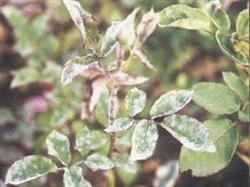Common diseases and insect pests of rose and their control

The common diseases of rose are rust, black mildew, powdery mildew and so on. Rust often harms the leaves, young branches and flowers of roses. In the early stage of the disease, the leaves appear red spots such as rust, and when the leaves are serious, the leaves become scorched and fall off, affecting flowering in the coming year. Diseased leaves should be removed in time and destroyed centrally. It can also be prevented by spraying 150-200 times equivalent Bordeaux solution every semimonthly from May to August. During the onset period, 300-fold solution of rust sodium can be sprayed for prevention and treatment. Black mildew, which mainly harms the base of leaves and buds, is serious in rainy, stuffy days and can cause a large number of fallen leaves. It can be sprayed with 3-5 degree stone-sulfur mixture before plant germination in early spring. At the initial stage of the disease, 50% thiophanate methyl wettable powder can also be sprayed with 600 times liquid spray, once every 10 days, and continuously sprayed 3-5 times according to the disease. The common pests of rose are rose stem and leaf wasp, rose night moth, blow cotton scale, red spider and so on. Rose stem and leaf wasp, a stem borer, mainly harms the stems of roses, causing branches to wither and cause plant death. When pruning the plant in winter, check the pulp of the root stubble and find that there are cavities, which can be dripped with 1-2 drops of 80% dichlorvos EC and sealed with mud. If the twigs are found to be infringed, they can be cut off and destroyed. Spodoptera litura that harms leaves with larvae and bites buds and flowers at the same time. It can be sprayed with 1000-1500 times liquid of 90% crystal trichlorfon or 1000 times solution of fenitrothion EC. The red spider harms the front and back of the leaves and leads to the withering and shedding of the leaves. In the early stage of the disease, 20% triclofenac EC or 20% triclofenac wettable powder 1000-1000 times can be sprayed, but the leaves should be sprayed once every 15 days, usually 1-2 times.
- Prev

Prevention and Control of Common Diseases of Rose
There are four common diseases of rose, such as powdery mildew, black spot, root cancer and branch blight, although other diseases such as exposure fungus, rust and anthracnose are occasionally found. And so on, but not as serious as the first four diseases. The symptoms and prevention methods are described as follows: rose black spot disease is a shield.
- Next

Cultivation techniques of Red Rose
Red Rosewood (Ochrosiacoccinea) is a plant of the genus Apocynaceae, distributed from Madagascar to Polynea in the Pacific Ocean. The red rosewood is a small evergreen tree with white milk, gray stems and bright green twigs. Leaves beautifully shaped, nearly leathery or stout papery, usually.
Related
- Fuxing push coffee new agricultural production and marketing class: lack of small-scale processing plants
- Jujube rice field leisure farm deep ploughing Yilan for five years to create a space for organic food and play
- Nongyu Farm-A trial of organic papaya for brave women with advanced technology
- Four points for attention in the prevention and control of diseases and insect pests of edible fungi
- How to add nutrient solution to Edible Fungi
- Is there any good way to control edible fungus mites?
- Open Inoculation Technology of Edible Fungi
- Is there any clever way to use fertilizer for edible fungus in winter?
- What agents are used to kill the pathogens of edible fungi in the mushroom shed?
- Rapid drying of Edible Fungi

